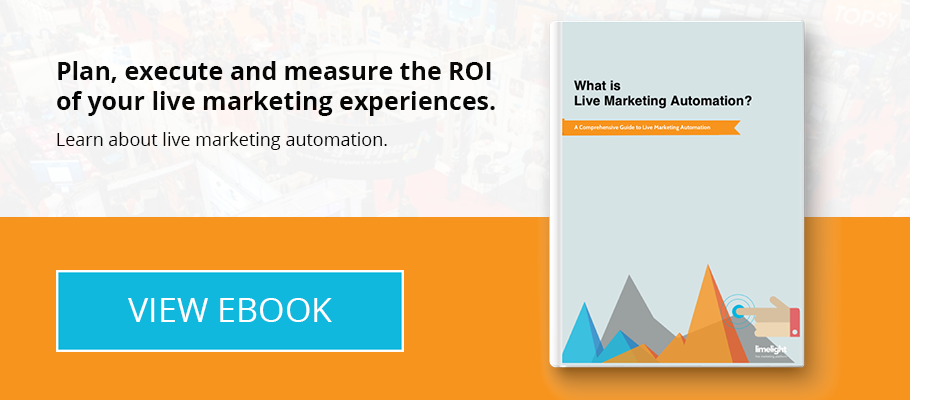How VR Can Supercharge Experiential Marketing Campaigns
.png?width=50&name=download%20(1).png) By
Julia Manoukian
·
3 minute read
By
Julia Manoukian
·
3 minute read
Experiential marketing is growing at an impressive rate, and the kinds of campaigns that perform best are changing. In the past, something as simple as a product sampling might have impressed customers. Nowadays, brands need to work harder to get the response they want.
To ensure a healthy return on investment, brands must create live marketing events that are engaging, immersive, shareable, and easily integrated with live marketing automation software.
Virtual reality ticks all of these boxes and more, as explained below.
Provides Better Consumer Experience
VR provides a highly immersive experience for consumers and has been highlighted by Joey Kercher at Forbes as a particularly effective way to target millennials.
It's been shown that young people value experiences over material items, and VR is an excellent way for brands to tap into this, providing novel experiences that promote their products.
A study from Touchstone Research showed that words like 'cool', 'awesome', 'excited,' and 'fun' were commonly used to describe experiences with VR. While consumers might not get as excited about traditional live marketing experiences, it's clear that VR holds a lot of appeal.  Creating an excellent consumer experience is at the forefront of experiential marketing. If people don't enjoy an event, there won't be any significant return on investment. Using VR as part of live campaigns is an effective way to drive engagement and provide an outstanding experience for participants.
Creating an excellent consumer experience is at the forefront of experiential marketing. If people don't enjoy an event, there won't be any significant return on investment. Using VR as part of live campaigns is an effective way to drive engagement and provide an outstanding experience for participants.
Increases Engagement Levels
VR is significantly more engaging than traditional experiential marketing campaigns, both in terms of encouraging participation and engaging viewers emotionally. That means that similar content presented using VR could elicit a much greater response than it would on a traditional platform.
That means that similar content presented using VR could elicit a much greater response than it would on a traditional platform.
When viewers are emotionally engaged in the experience provided, they'll feel a stronger connection to the brand and will be more likely to engage after the event is over.
As well as providing emotional engagement, using VR increases the chance that people will stop and take notice of an event. A study by Greenlight VR showed that 60% of Americans are interested in trying VR gaming. Even if people aren't interested in a brand, there's a good chance they'll engage in live events purely for the novelty of using VR technology.
Encourages Word-of-Mouth Sharing
When people have a great live marketing experience, they tell people about it. This is likely to be equally true for branded VR experiences, which makes them a really powerful marketing tool.
This is likely to be equally true for branded VR experiences, which makes them a really powerful marketing tool.
Emily Lyons at Huffington Post Canada points out that experiential marketing was one of the most effective core marketing strategies in 2017, partly because of its impressive word-of-mouth reach. When someone takes part in a positive live brand experience, they're likely to tell approximately 17 other people about it -- that's an excellent ROI per experience.
Can Be Linked to Social Media Campaigns
Experiential marketing that uses VR is easy to link to social media campaigns. For example, brands might offer a photo of users wearing a VR headset, then encourage them to share it online using a dedicated hashtag.
VR experiences can also be linked to live marketing automation software to capture valuable information about consumers before and after their experience. This could include asking users to fill in a form prior to their experience, and asking for details which can be used to connect with them on social media after the event is over. Automation software can trigger automatic responses to certain consumer behaviors, meaning that every opportunity for engagement is taken advantage of.
Works with Marketing Automation
Running experiential marketing campaigns without a plan for analyzing results and encouraging further engagement makes no sense -- and that's where marketing automation software comes in handy.
When working with traditional live marketing campaigns, like giveaways and samples, it can be hard to capture enough consumer data to work with. However, when using VR as part of a campaign, it's easy to capture data before, during, and after the experience. Consumers will be more willing to give details about themselves when they're benefiting from a novel, unique experience, and this makes follow-up marketing much easier.
Brands are able to closely track the success of their events by analyzing the data captured by their experiential marketing software. Analyzing results in real-time allows brands to make changes to their experience on the day -- for example, by changing the questions on forms to encourage more in-depth answers, or promoting the event through a certain channel that performs better than others.
While other events are difficult to measure precisely, VR experiences are easy. It's possible to track how many people participate, how long they spend engaged in the experience, and whether or not they engage with the brand again. This can inform future campaigns and help maximize ROI.
Virtual reality is the way forward for experiential marketing. It provides a unique, engaging consumer experience, encourages word-of-mouth and social media sharing, and is easy to integrate with experiential marketing software for access to powerful analytics and follow-up tools.

